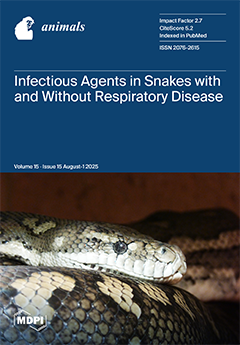This study was conducted to investigate the effects of puffed jujube powder (PJP) supplementation in the diet on the slaughter characteristics, growth performance, meat quality, and serum antioxidant capacity of Hainan Black (HB) goats. Twenty-four healthy male HB goats, three months old with
[...] Read more.
This study was conducted to investigate the effects of puffed jujube powder (PJP) supplementation in the diet on the slaughter characteristics, growth performance, meat quality, and serum antioxidant capacity of Hainan Black (HB) goats. Twenty-four healthy male HB goats, three months old with an initial body weight of 15.12 ± 3.67 kg, were randomly divided into three groups: the 10% PJP group (basal diet plus 10% PJP); the 20% PJP group (basal diet plus 20% PJP); and the control group (basal diet only). After a 10-day adaptation period, a feeding trial was carried out for 90 days in an ad libitum diet environment. The results show that the final body weight of the 20% PJP group was markedly higher (
p < 0.05) than that of the control group (22.58 ± 0.94 kg vs. 20.45 ± 1.01 kg). The average daily gain of the 20% PJP group was 83.44 ± 1.78 g/d, which was substantially greater (
p < 0.05) than the 59.22 ± 2.13 g/d of the control group. The feed intake of the 20% PJP group was 713.10 ± 4.54 g/d, notably higher (
p < 0.05) than the 498.20 ± 4.33 g/d of the control group. In terms of slaughter characteristics, the carcass weight of the 20% PJP group was 13.99 ± 1.22 kg, considerably heavier (
p < 0.05) than the 11.79 ± 1.38 kg of the control group. The muscle weight of the 20% PJP group was 11.43 ± 1.42 kg, distinctly greater (
p < 0.05) than the 9.59 ± 1.99 kg of the control group. The slaughter rate of the 20% PJP group was 42.41%, showing a notable increase (
p < 0.05) compared with the 37.42% of the control group, and the net meat rate of the 20% PJP group was 34.65%, with a significant rise (
p < 0.05) compared with the 30.43% of the control group. Regarding serum antioxidant capacity and meat quality, the activities of serum antioxidant enzymes, superoxide dismutase (SOD) and catalase (CAT), were conspicuously increased (
p < 0.05) in the 20% PJP group. The meat shear force of the 20% PJP group was decreased by 12.9%, and the cooking loss was improved by 8.9% in comparison with the control group. In conclusion, the supplementation of 20% PJP in the diet was demonstrated to enhance the growth performance, improve the meat quality, and boost the antioxidant status of HB goats, thus presenting a feasible strategy for optimizing tropical goat production systems.
Full article






